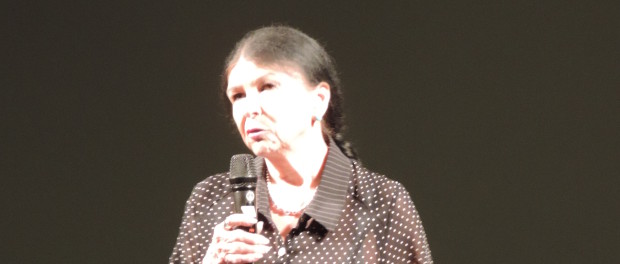Pursuing Shannen’s Dream : Alanis Obomsawin on Hi-Ho Mistahey!
Last Monday, I attended the last weekly Cinema Politica screening of the season at Concordia University and it broached the topic of First Nations rights in regards to education. The documentary broadcast that night was Hi-Ho Mistahey! by Alanis Obomsawin, Abenaki well-known director of Aboriginal themed-films. The 80-year-old woman told me about her commitment to advancing minorities’ rights, especially First Nations’ rights, and in particular, the low level of education in Attapiskawat schools and the demand for equal consideration and treatment addressed to the Government of Canada.
https://www.youtube.com/watch?v=h9v9qHXmM2k
Mylène Chevreul (MC) :Tell us more about this enigmatic title in Cree language.
Alanis Obomsawin (AO) : Hi-Ho Mistahey means “I love you infinitely.” It is a family saying used in the context of children leaving their home. And here the documentary related precisely the story of First Nation children forced to campaign to get a new school and to have their voice heard regarding equal education. Many pupils were compelled to flee their hometown to be able to finish secondary school and it meant saying goodbye to all their loved ones.
MC : Alright,I understand the film’s first footage better now as well as its ending. Can you tell me more about “Shannen’s Dream,” the Attawapiskat children’s collective action?
AO: Back in 2008, a girl named Shannen Koostachin, aged 14, decided to create an association to prompt the government to action after the school had been contaminated by an oil spill but yet left as is. The association wore her name and some thousands children felt the necessity to keep on fighting for their rights after Shannen unexpectedly died in a car accident. The documentary features six pupils from the school delegated to represent their interests in the United Nations Conference in Geneva.
MC: How did you get involved with this school ?
AO: All my life, my main interests have been children and education. I got in touch with Cindy Blackstock (Canadian-born Gitxsan activist for child welfare and Executive Director of the First Nations Child and Family Caring Society of Canada) and she told me what was happening and she spoke about “Shannen’s Dream.” Then, I decided to check it out for myself, that’s how I ended up making two films because while I was making this one, the housing problem occurred and I could see how damaging it was. So, I put this one aside and made The People of the Kattawapiskak River (2012) and then after that, I went back to continue this film.
MC: So it has been an ongoing process…
AO: Since 2010… but yes, it takes time to get all the voices heard.
MC: The idea of transmission and legacy infuses all your works, both engravings and documentaries, what transpires behind this leitmotiv of yours?
AO: It’s important to me, yes, because our history has been vanished; it was never taught in schools. But when we appeared in books, it was selective teaching and it created a lot of hatred towards our people for many years. That is why what we leave behind is very important, and that concerns each community.
MC: The screening was a special occasion bringing you and Cinema Politica together again.
AO: Yes they’ve shown several of my films already and it’s very much in their interest to screen such themes. And in such places as a university, the documentary can be made mainstream, accessible and become a tool for empowerment. Just like it has been for many years now. And there will always be a need for documentary. It’s a place for people to have a voice, to say what they want to accomplish in life, to expose injustices.
MC: What are your new projects now, after 40 years of career and 42 documentaries?
AO: We’re working on a new film, which will hopefully be out in the fall, and I’ll write a book if I don’t die before that!
MC:No, you really seem unstoppable, thank you for your commitment and we’re looking forward to hearing from all those new things on the way.
AO: Thank you, it’s very nice.
Hi-Ho Mistahey can be seen on the National Film Board Website. Click HERE.






